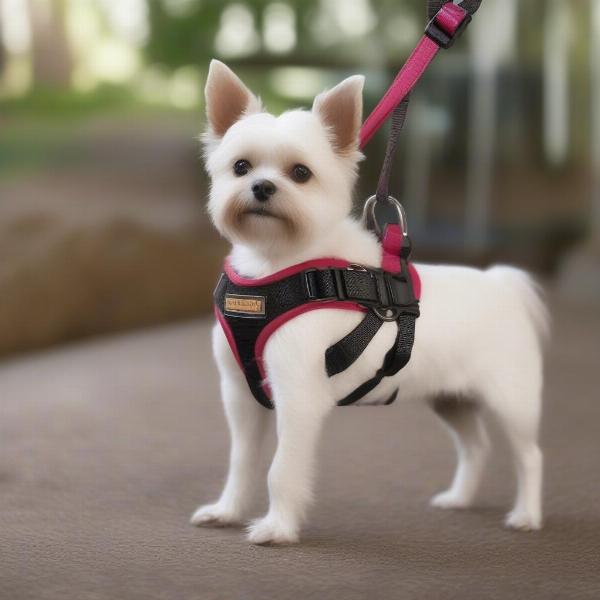Step in dog harnesses offer a convenient and comfortable alternative to traditional over-the-head harnesses. They are particularly beneficial for dogs who dislike having things pulled over their heads or for owners who find traditional harnesses fiddly. This guide explores everything you need to know about step in dog harnesses, from choosing the right size and fit to the various types available.
Choosing the Right Step In Dog Harness
Selecting the correct step in harness is crucial for your dog’s comfort and safety. Consider your dog’s breed, size, and body shape. Measure your dog’s girth and chest circumference accurately to ensure a snug but not restrictive fit. Adjustable straps allow for a customized fit and accommodate growth, especially in puppies.
A properly fitted step in harness should allow two fingers to fit comfortably between the harness and your dog’s body. Too tight, and it can restrict breathing and movement; too loose, and your dog could slip out.
Types of Step In Dog Harnesses
Step in harnesses come in various styles, each designed for specific needs. Some popular types include:
- Basic Step In Harness: Ideal for everyday walks and training, this type features a simple design with two straps that fasten around the dog’s back. step in dog harness
- Vest Style Step In Harness: Offering more coverage and support, vest harnesses are suitable for dogs who pull or are prone to escaping.
- No-Pull Step In Harness: Designed to discourage pulling, these harnesses typically have a front clip attachment that redirects the dog’s forward motion.
Consider your dog’s temperament and walking habits when selecting a type of step in harness.
How to Put on a Step In Dog Harness
Putting on a step in harness is straightforward. Lay the harness flat on the ground, with the straps open. Guide your dog’s front paws into the designated leg holes. Lift the harness up and fasten the straps securely. step in dog harness for small dogs Ensure the harness is snug but not restrictive.
Benefits of Using a Step In Dog Harness
Step in harnesses offer several advantages over traditional collars and over-the-head harnesses:
- Easier to Put On: Ideal for dogs who dislike having things pulled over their heads.
- Reduced Risk of Injury: Distributes pressure more evenly across the chest, minimizing strain on the neck and trachea.
- Better Control: Provides better control, especially for dogs who pull.
- Increased Comfort: Generally more comfortable than traditional collars, especially for brachycephalic breeds.
“Step-in harnesses are a great choice for many dogs, especially those who are sensitive around their head or neck,” says Dr. Emily Carter, DVM. “They offer a safe and comfortable alternative to traditional collars, promoting better control and reducing the risk of injury.”
Step In Harnesses for Small Dogs
Smaller breeds often benefit from the ease of use and comfort of step in harnesses. step in dog harness for small dog Look for harnesses specifically designed for small dogs, with lightweight materials and adjustable straps to ensure a perfect fit.  Small Dog Wearing a Step-in Harness
Small Dog Wearing a Step-in Harness
“For small breeds, a well-fitting step-in harness is essential,” adds certified dog trainer, Mark Johnson. “It provides better control during walks and minimizes strain on their delicate necks.”
Conclusion
Step in dog harnesses provide a practical and comfortable solution for dog owners seeking a safe and convenient alternative to traditional collars and harnesses. By carefully considering your dog’s size, breed, and temperament, you can select the perfect step in harness to enhance your walks and training sessions. step in dog harness small
FAQ
- How do I know if a step in harness fits my dog correctly? You should be able to fit two fingers comfortably between the harness and your dog’s body.
- Are step in harnesses suitable for all breeds? Yes, but consider your dog’s individual needs and temperament.
- What are the benefits of a step in harness over a collar? Step in harnesses distribute pressure more evenly, reducing strain on the neck and trachea.
- Can I use a step in harness for training? Yes, many step in harnesses are suitable for training.
- How do I clean a step in harness? Most harnesses can be hand washed or machine washed on a gentle cycle.
- Are step in harnesses better for pulling dogs? Some step in harnesses are designed specifically to discourage pulling.
- Where can I buy a step in harness? Pet stores and online retailers offer a wide selection of step in harnesses. step in dog harness uk
ILM Dog is your one-stop resource for expert advice on all aspects of dog care, from breed selection to health, training, and nutrition. We provide practical, trustworthy information to empower dog owners worldwide. For expert guidance tailored to your dog’s needs, contact us at [email protected] or call us at +44 20-3965-8624. Visit ILM Dog for more valuable insights and resources.